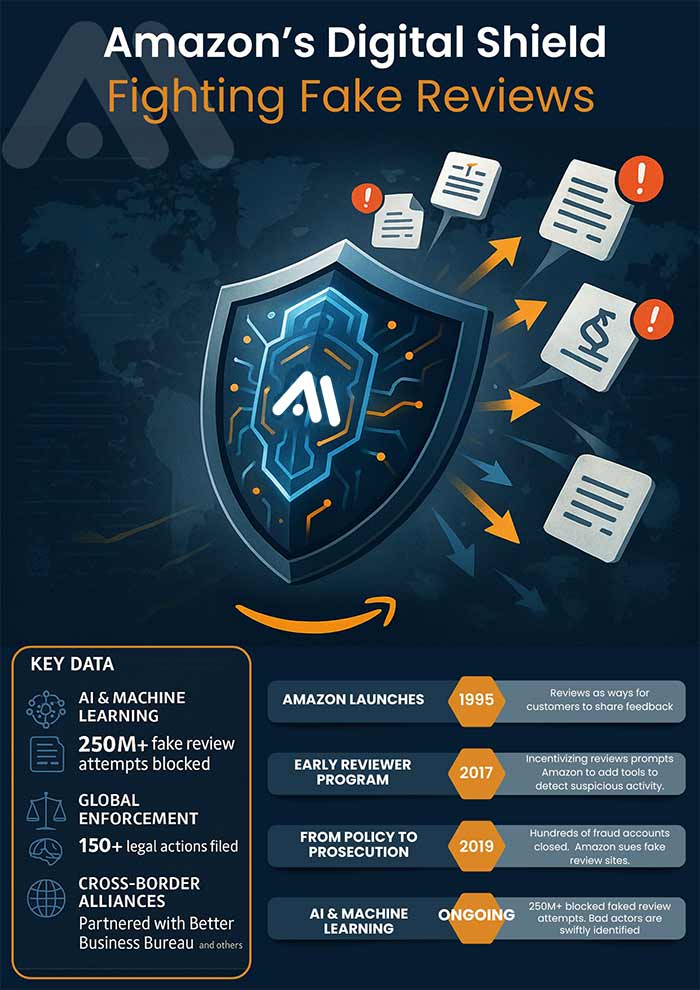In the fast-moving world of Amazon FBA, product reviews aren’t just important—they’re everything. For buyers, they build trust. For sellers, they drive sales and rankings. But behind the star ratings lies a story of manipulation, reform, and high-stakes legal action.
This is the story of how Amazon seller account reviews have evolved—especially between 2017 and 2019—as Amazon transformed from turning a blind eye to fake reviews to leading global legal crackdowns against them.
The Early Days: When Incentivized Reviews Ruled
Long before today’s stringent policies, incentivized reviews on Amazon were the norm. Sellers offered free or deeply discounted products in exchange for glowing feedback. These tactics helped new products rapidly accumulate hundreds of five-star reviews, even if the quality didn’t match the rating.
Keywords like “Amazon product review strategy” and “how to get reviews on Amazon” exploded in popularity during this era—but the system was easy to abuse, and trust began to erode.
2017: Amazon’s First Major Crackdown on Fake Reviews
By 2017, Amazon had seen enough.
The platform launched the Amazon Early Reviewer Program, allowing brand-registered sellers to collect honest reviews in a structured, Amazon-sanctioned format. This marked a critical turning point in Amazon’s fake review policy.
At the same time, Amazon:
Implemented automated tools to flag suspicious review activity
Monitored unusual review velocity and seller behavior
Rolled out clear anti-manipulation policies for all sellers
While these moves helped curb basic abuse, many review manipulators simply adapted. They moved operations off-platform—onto Telegram, Discord, Facebook groups, and shady websites.

2019: From Policy to Prosecution
Realizing that enforcement alone wasn’t enough, Amazon took its most aggressive step yet in 2019: launching legal action against fake review brokers.
This phase saw:
Lawsuits filed against individuals and companies offering fake Amazon reviews
Partnerships with authorities in the U.S., Europe, and China
Criminal referrals in cases involving large-scale fraud
The term “Amazon sues fake review sites” started trending in search queries. These lawsuits became a serious deterrent, leading to the shutdown of hundreds of review manipulation networks and raising the stakes for anyone attempting to game the system.
Amazon’s Ongoing Battle: AI, Machine Learning & Global Enforcement
Since 2019, Amazon has doubled down on AI and machine learning to catch fraudulent reviews before they appear. In 2023, Amazon reported:
Blocking over 250 million fake review attempts
Taking legal action against 150+ entities engaged in review fraud
Amazon also partners with organizations like the Better Business Bureau to jointly tackle review scams across international borders.
Search interest in terms like “how Amazon detects fake reviews” and “Amazon review AI system” continues to rise, reflecting seller concerns and buyer curiosity.
Why This Matters for Today’s Amazon Sellers
As Amazon’s review policies have matured, so has its enforcement. For modern sellers, this means:
No shortcuts to earning reviews—authenticity is mandatory
Strict review monitoring on every seller account
Legal risks for any attempt to manipulate product ratings
If you’re buying an aged Amazon seller account or launching new products, understanding Amazon’s review history—and current enforcement—is critical to long-term success.
Final Thoughts: Trust Is the New Currency
The evolution of Amazon seller account reviews from incentivized tactics to high-profile lawsuits reflects a marketplace maturing in real time. For sellers, it’s no longer just about volume—it’s about credibility, compliance, and customer trust.
So the next time you see a five-star rating, know there’s a powerful system behind it—one that’s still evolving to protect both buyers and honest sellers.
Want to scale with a compliant, trusted Amazon account?
📩 Contact AIA Assets to explore vetted aged seller accounts with positive review histories and full transparency.

